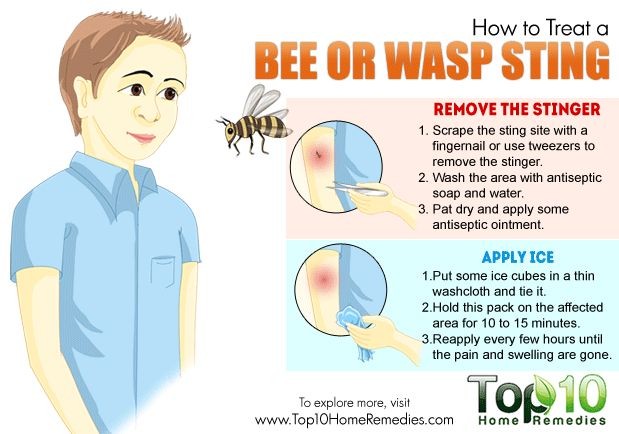
Contents
- 1 Bee and Wasp Sting
- 1.0.1 Types of Wasps
- 1.0.2 Types of Bees
- 1.0.3 Causes of Bee and Wasp Stings
- 1.0.4 Symptoms of Bee or Wasp Sting
- 1.0.5 When to Call a Doctor about a Bee or Wasp Sting?
- 1.0.6 Diagnosis of Bee or Wasp Sting
- 1.0.7 Treatment for Bee or Wasp Sting
- 1.0.8 Complications of Bee or Wasp Sting
- 1.0.9 Prevention of Bee or Wasp Sting
Bee and Wasp Sting
Bee and wasp stings are common causes of medical problems. Bees and wasps, along with fire ants, belong to the Hymenoptera order. Stings can cause reactions ranging from pain and swelling to serious and potentially fatal conditions. Each year, 90 to 100 deaths occur in the U.S. due to anaphylactic sting reactions.
Types of Wasps
Over 25,000 species of wasps are found worldwide. Some common types include:
- The yellow jacket and hornet, both living in groups in temperate climates.
- Yellow jackets, with black and yellow stripes on the abdomen, form underground nests.
- Hornets are predominantly black with some yellow markings on the head and thorax. They form paper-like nests attached to trees, bushes, or buildings.
Types of Bees
Bees include honey bees, Africanized honey bees (also known as "killer bees"), and bumble bees. Bumble bees are large, furry-appearing bees that pollinate many plants. Honey bees are found worldwide and sting if bothered. "Killer bees" found in the Western and Southern U.S. may chase victims and attack in greater numbers, increasing the chances of a severe reaction. There are over 20,000 species of bees worldwide.
Causes of Bee and Wasp Stings
Most stings occur when an insect perceives a threat to their colony. Bees and wasps sting when their hive or nest is approached. Loud noises, bright or dark colors, and certain perfumes may also encourage stings. Some venom contains pheromones, which attract other colony members to sting.
When bees or wasps sting, they inject venom under the skin. Honey bees have barbed stingers that tear off, causing them to die after stinging once. Bumble bees, hornets, yellow jackets, and wasps can sting multiple times since their stingers are smooth.
Bee and wasp venoms vary by species and can contain toxic components and antigens that stimulate an immune response.
Symptoms of Bee or Wasp Sting
Insect stings may produce four types of reactions:
- Local reactions: Symptoms include pain, swelling, warmth, redness, and itching at the sting site. Large local reactions may last up to a week, accompanied by nausea and tiredness. These reactions are not allergic reactions.
- Systemic allergic reactions: Occur in people who have produced IgE antibodies against the same insect venom. Symptoms include hives, flushing, difficulty breathing, and swelling. Severe reactions can be life-threatening.
- Toxic reactions: Result from toxins in the venom. Symptoms can include fever, nausea, vomiting, diarrhea, headache, and convulsions. Hives and rashes are less common in toxic reactions.
- Delayed reactions: Uncommon and occur days to weeks after the sting. Symptoms can include inflammation of the brain, nerves, blood vessels, kidneys, and blood clotting disturbances.
QUESTION
When to Call a Doctor about a Bee or Wasp Sting?
Most stings can be treated at home, but some require medical attention. Seek immediate emergency medical assistance if there is suspicion of a systemic allergic reaction. Also, seek care for multiple stings, stings in the eye area, signs of infection, worsening symptoms, or severe symptoms in young children, the elderly, or those with chronic medical problems.
Medical Care Should be Sought for the Following Conditions:
- If you have received multiple stings
- If the sting is located in the eye or eye area
- If symptoms of infection develop
- If initial symptoms worsen or persist for longer than 24 to 48 hours
- If children, elderly, or those with chronic medical problems experience severe symptoms
Diagnosis of Bee or Wasp Sting
In most cases, the sting is witnessed. Symptoms and history are typically sufficient to establish a diagnosis.
Treatment for Bee or Wasp Sting
Treatment for Mild Allergic Reaction and Home Remedies
- Cleanse the site and remove the stinging apparatus if present. Apply ice or cold packs.
- Take antihistamines to relieve itching and burning. Take pain relievers if needed.
- If the site becomes infected, antibiotics may be prescribed.
- Get a tetanus booster if it has been more than 10 years since the last one.
Treatment for mild allergic reactions usually involves antihistamine and sometimes steroid medications.
Treatment for Anaphylactic Reaction
The treatment of choice is epinephrine. Emergency medical treatments may also include steroid and antihistamine medications, breathing tube insertion, and cardiovascular support. Epinephrine kits can be life-saving and should be readily available.
Immunotherapy may be recommended for those with a history of severe allergic reactions. Allergy shots can reduce the chance of future severe reactions.
Complications of Bee or Wasp Sting
Complications can include infection at the sting site and life-threatening systemic allergic reactions.
Prevention of Bee or Wasp Sting
Preventive measures include avoiding hives and nests, avoiding fragranced body products and bright colors, wearing protective clothing, and staying cautious outdoors.
References: Vankawala, H. H., et al. “Hymenoptera Stings.” Medscape. 24 Sept. 2015.
Medically reviewed by Joseph Palermo, MD; Board Certificate: Internal Medicine/Geriatric Medicine


